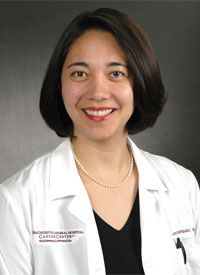Promise Seen With EGFR Inhibitor CO-1686 in Treatment-Resistant NSCLC
The third-generation EGFR inhibitor CO-1686 continues to demonstrate promising activity in patients with non–small cell lung cancer (NSCLC) who developed resistance after prior treatment with an EGFR tyrosine kinase inhibitor (TKI).
Dr. Lecia V. Sequist from MGH Cancer Center

Lecia V. Sequist, MD, MPH
The third-generation EGFR inhibitor CO-1686 continues to demonstrate promising activity in patients with nonsmall cell lung cancer (NSCLC) who developed resistance after prior treatment with an EGFR tyrosine kinase inhibitor (TKI), according to the latest phase I/II results from the TIGER research program.
In the phase I study, and based on early findings from the ongoing phase II trial, the agent yielded a 58% overall response rate (ORR) across all dose levels in trial participants with biopsy-confirmedEGFRT790Mmutations. Additionally, the compound did not cause the skin rash and diarrhea commonly associated with earlier generations of EGFR inhibitors.
Lecia V. Sequist, MD, medical oncologist at Massachusetts General Hospital in Boston and associate professor of Medicine at Harvard Medical School, presented the trial results during a clinical science symposium at the 2014 ASCO Annual Meeting and discussed them in an interview withOncLive.
Patients receiving EGFR TKI therapy for advanced NSCLC develop usually resistance after about 1 year, Sequist explained, and this resistance is often due to theT790Mmutation, which occurs in approximately 50% to 60% of EGFR-treated patients. She said that this mutation emerges most typically after EGFR therapy; however, there are a very small number of patients who will have this mutation as a part of their tumor.
“There is actually some debate in the field about why [the mutation] is so common at the time of resistance,” Sequist continued. “Is it that it’s actually in most people at the time of diagnosis, and it’s just so small that you can’t detect it and as you treat with an EGFR TKI, the mutation grows out? Or, is there a change that occurs molecularly as the patient goes through treatment?”
In addition to inhibitingT790Mresistance mutations in EGFR-treated patients, CO-1686 also spares the wild-type EGFR signaling that can cause significant rash and diarrhea.
Sequist said that the phase I dose-escalation portion of the study involved 72 patients with a median of two prior TKI lines of therapy and focused on pharmacokinetics, optimum dosing, and safety. In August 2013, Clovis Oncology, the manufacturer of CO-1686, transitioned the drug’s formulation from a freebase capsule to its current hydrobromide salt (Hbr) tablet form. The agent was granted a breakthrough therapy designation by the FDA on May 20.
Activity with CO-1686 was seen across all Hbr dose levels, said Sequist, and the results so far for progression-free survival have been promising as welllonger than 1 year—though the data are not yet mature. She added that although the investigators are still accruing data on the most efficacious dose through the phase II portion of the trial, “right now, it looks like it may be a dose of 625 mg, twice daily.”
Most of the adverse events observed in the trial have been infrequent and mild, Sequist said, with the most common being nausea and hyperglycemia. High blood sugar is not something commonly seen in other EGFR inhibitors, she added. Most of the patients can be successfully managed by dose-reducing the study drug and adding a sugar-lowering medicine, commonly metformin.
“Importantly, this drug does not cause the typical side effects that we’re used to seeing with EGFR inhibitors,” Sequist continued, such as rash and diarrhea with the first- and second-generation agents that inhibit EGFR.
The ongoing phase II trial (NCT01526928) is examining twice-daily dosing of CO-1686 at levels of 500, 625, or 750 mg as second-line therapy in two expansion cohorts ofT790M-positive patients. The agent is being administered immediately upon one prior TKI in one group, and in the second group, after ≥2 lines of TKI therapy or chemotherapy.
“There is a lot of enthusiasm because of the activity that has been seen with this compound,” said Sequist, and three other trials in the TIGER program are enrolling patients in 2014.
TIGER 1 is a phase II/III trial comparing CO-1686 with erlotinib as first-line therapy in treatment-naïve patients withEGFRmutations who have not been screened forT790Mstatus. TIGER 2 is a single-arm, phase II trial evaluating CO-1686 as second-line therapy in patients withEGFR-mutated NSCLC who areT790M-positive. The randomized phase III TIGER 3 trial will evaluate CO-1686 versus chemotherapy in patients who have progressed on a first-line EGFR TKI and are alsoT790M-positive.
Sequist LV, Soria JC, Gadgeel SM, et al. First-in-human evaluation of CO-1686, an irreversible, highly selective tyrosine kinase inhibitor of mutations of EGFR (activating and T790M).J Clin Oncol.2014;32:5s (suppl; abstr 8010).
<<<